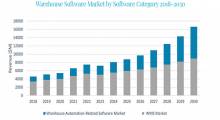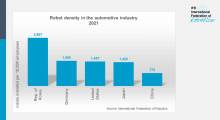The operational stock of industrial robots has increased by 13% on average for each year from 2015 to 2020, reaching a new record of about 3 million units worldwide, according to the International Federation of Robotics. The Frankfurt, Germany-based organization has analyzed the top five trends shaping robotics and automation globally.
“Transformation for robotic automation is picking up speed across traditional and new industries,” stated Milton Guerry, president of the International Federation of Robotics (IFR).
Founded in 1987, the IFR represents national robotics associations, research institutions, and robot manufacturers from more than 20 countries. The nonprofit compiles statistics including robot density, or number of units per 10,000 employees, for the degree of automation in multiple nations.
The IFR this week listed the following robotics trends for 2022:
1. New industries adopt automation
Segments that are relatively new to automation, beyond automotive manufacturing, are rapidly adopting robots, said the IFR. Consumer behavior is driving companies to address demand for personalization of both products and rapid delivery.
The e-commerce revolution was driven by the COVID-19 pandemic and will continue to accelerate in 2022, it predicted.
2. Robots become easier to use
New generations of robots are designed to be easier to use. There is a clear trend towards user interfaces that allow simple icon-driven programming and the manual guidance of robots.
Robot companies and some third-party suppliers are bundling hardware packages with software to ease implementation. Offerings that focus on complete ecosystems can add value by reducing the effort and the time to operation, the IFR noted.
3. Both robots and humans up-skilling
More and more governments, industry associations, and companies are seeing the need for basic robot and automation education at an early stage for the next generation, said the IFR. In addition to the training of workers in-house, external education routes can enhance staff learning programs.
Robot manufacturers such as ABB, FANUC, KUKA, and Yaskawa all register between 10,000 and 30,000 participants in their robot classes across more than 30 countries every year.
4. Robots secure production
International trade conflicts and the pandemic are driving manufacturing back closer to the customer. Supply-chain problems are leading companies to consider nearshoring, with automation as part of the solution.
5. Robots support digitization
In 2022 and beyond, the IFR said it expects an emphasis on data as a key enabler of future production. Manufacturers will analyze data collected from intelligently automated processes to make more informed decisions.
With a robot’s ability to share tasks and learn through artificial intelligence, companies will also be able to adopt smart machines more easily, it added.
Other IFR reports available
The IFR Statistical Department provides industry data for two statistical yearbooks.
In “World Robotics—Industrial Robots,” the organization provides worldwide statistics on industrial automation with tables for comparisons. It contains statistical data from over 40 countries, broken down by application area, Industrial sectors, types of robots, and other technical and economic aspects. The report also lists production, export, and import dates for selected countries.
In “World Robotics—Service Robots,” the IFR provides worldwide statistics on service robots, market analyses, and sales potential for service robots in commercial operations and private applications, such as the BlueBotics cleaning robot shown above.
Article topics
Email Sign Up

















